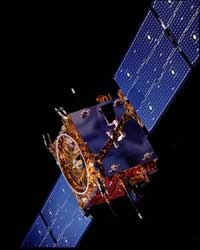ESA takes a new look at the Moon

ESA’s SMART-1: testing solar electric propulsion and studying the Moon <br>© ESA
Thirty years after Apollo 16’s lunar module, Orion, landed at the western edge of the Descartes Mountains on 21 April 1972, there is still much that we don’t know about the Moon. For instance, how was it created? And what role did it play in the formation and evolution of Earth?
We may be closer to answering those, and many other questions, thanks to ESA’s mission to the Moon, known as SMART-1. Due to be launched early in 2003, the main purpose of the SMART-1 mission is to flight-test the new Solar Electric Propulsion technology – a kind of solar-powered thruster that is ten times more efficient than the usual chemical systems employed when travelling very long distances. If all goes well, such a system could be providing the propulsion system for future ESA missions into deep space, such as BepiColombo.
And, in the process, the mission will be providing some fascinating science. For instance, SMART-1 will be mapping the Moon more accurately than ever before, flying over all the Apollo landing sites. Thirty years ago, Apollo 16 carried six hand-held cameras to photograph the Moon’s surface. SMART-1 will be leading the way in the latest imaging techniques. Images taken from many different angles and X-ray and infrared detection work will allow scientists to draw up new three-dimensional models of the Moon’s surface.
SMART-1 will be looking at the darker parts of the Moon’s south pole for the first time. And it will be accurately mapping the Peak of Eternal Light, an eerie mountaintop that is permanently bathed in sunlight, while all around are dark craters never touched by the Sun. These craters are believed to harbour ice in the soil. SMART-1 will help scientists to understand if ice is present at the lunar poles.
Media Contact
All latest news from the category: Physics and Astronomy
This area deals with the fundamental laws and building blocks of nature and how they interact, the properties and the behavior of matter, and research into space and time and their structures.
innovations-report provides in-depth reports and articles on subjects such as astrophysics, laser technologies, nuclear, quantum, particle and solid-state physics, nanotechnologies, planetary research and findings (Mars, Venus) and developments related to the Hubble Telescope.
Newest articles

Simplified diagnosis of rare eye diseases
Uveitis experts provide an overview of an underestimated imaging technique. Uveitis is a rare inflammatory eye disease. Posterior and panuveitis in particular are associated with a poor prognosis and a…

Targeted use of enfortumab vedotin for the treatment of advanced urothelial carcinoma
New study identifies NECTIN4 amplification as a promising biomarker – Under the leadership of PD Dr. Niklas Klümper, Assistant Physician at the Department of Urology at the University Hospital Bonn…

A novel universal light-based technique
…to control valley polarization in bulk materials. An international team of researchers reports in Nature a new method that achieves valley polarization in centrosymmetric bulk materials in a non-material-specific way…





















